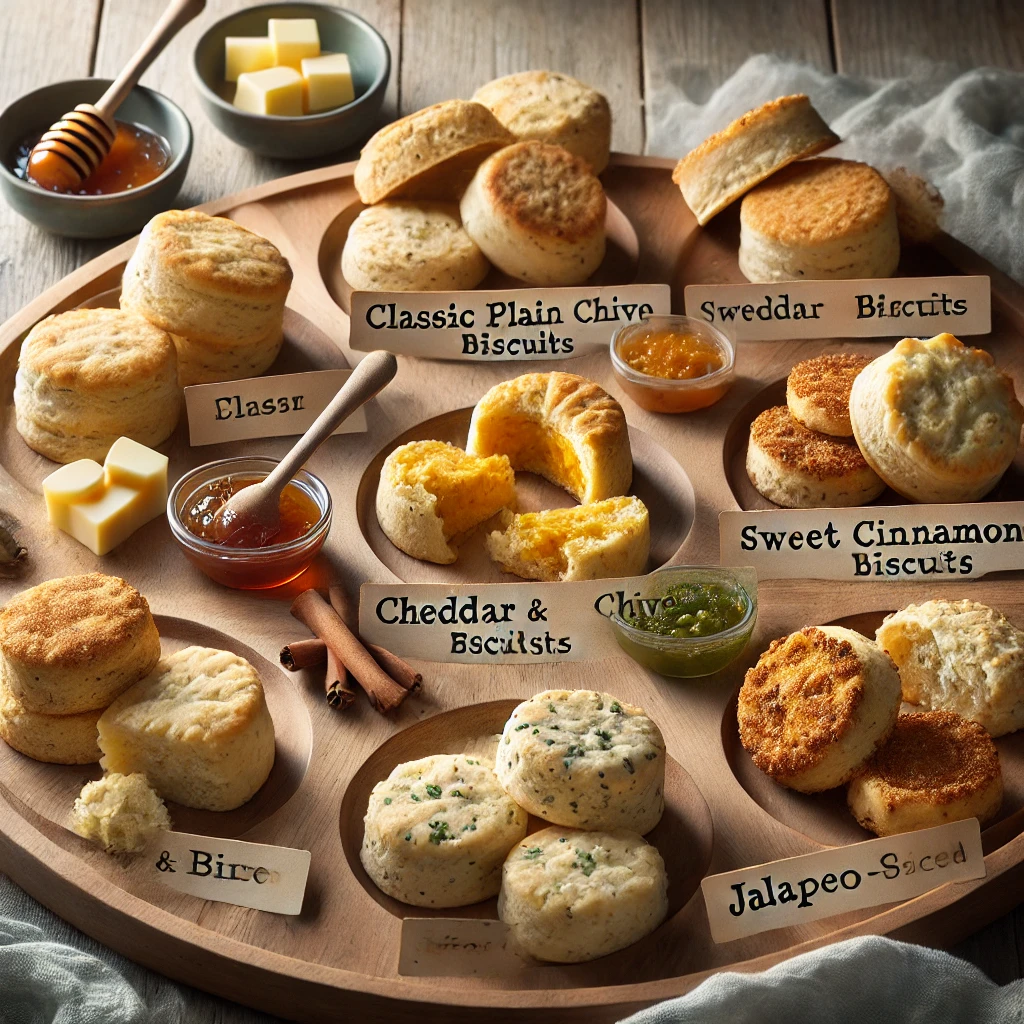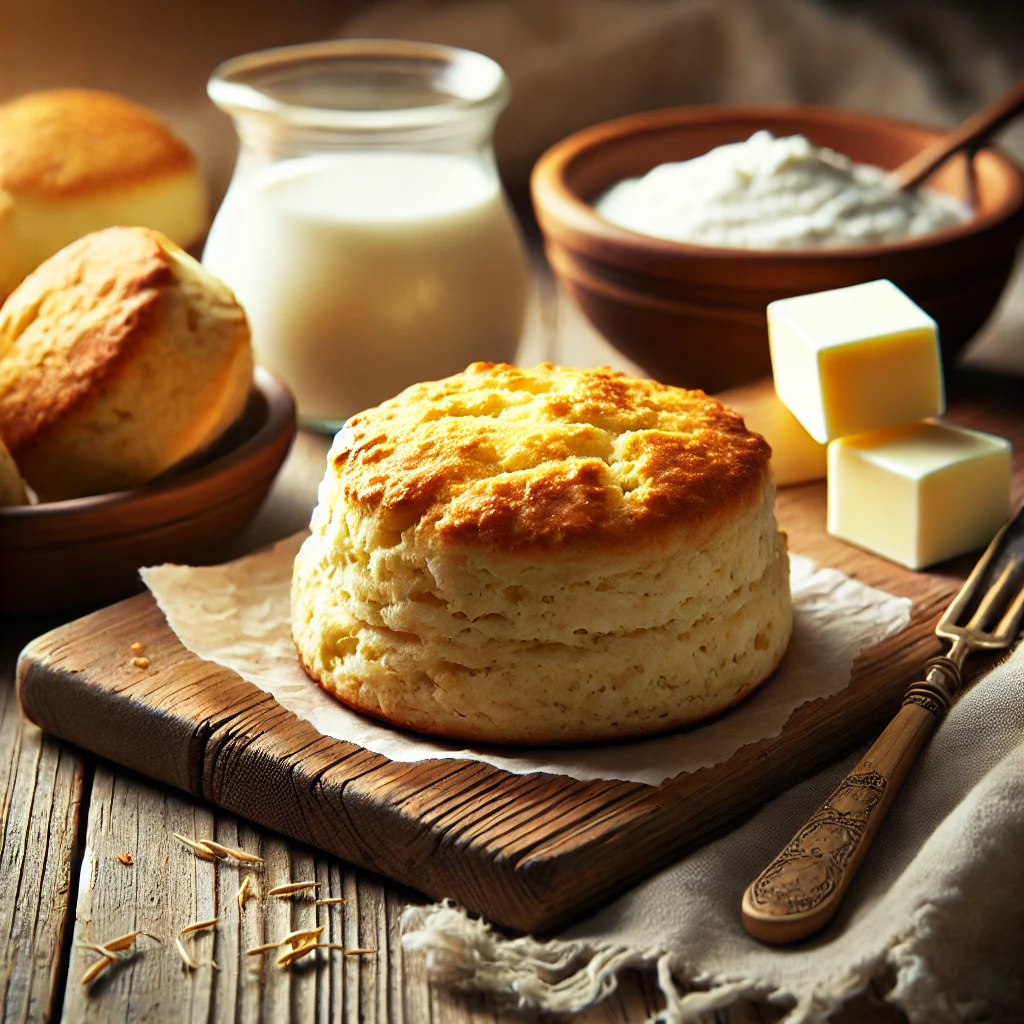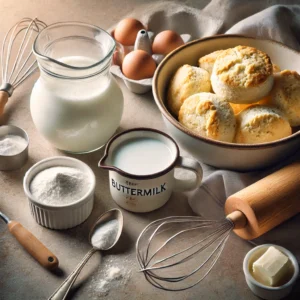The Science Behind Buttermilk in Baking Biscuits
The magic of buttermilk in biscuits lies in its chemistry. Understanding the science behind its role can help you better appreciate why it’s a superior choice to milk:
1. Acidic Properties
Buttermilk’s acidity works wonders in baking:
- Reacting with Baking Soda: The acid in buttermilk reacts with the alkaline baking soda, releasing carbon dioxide gas. This process creates air pockets that result in the signature fluffiness of buttermilk biscuits.
- Gluten Control: The acid also helps tenderize gluten, making biscuits softer and less chewy.
2. Hydration and Structure
Buttermilk has a thicker consistency than milk, which means it clings to the flour better during mixing. This results in:
- Better hydration of the dough for a smoother texture.
- Improved structure, giving biscuits a stable rise without being crumbly.
3. Flavor Amplifier
The tangy flavor of buttermilk isn’t just for taste. It enhances other ingredients like butter, cheese, and herbs, making savory biscuits richer and more complex.
Pro Tips for Baking Biscuits with Buttermilk
To make the most of buttermilk in your biscuit recipes, follow these expert tips:
1. Chill Your Ingredients
- Buttermilk should be cold to help keep the butter solid. Solid butter creates steam pockets as the biscuits bake, leading to those desirable flaky layers.
2. Don’t Overmix
- Mix just until the dough comes together. Overmixing activates gluten, which can make biscuits dense and tough.
3. Cut the Dough Properly
- Use a sharp biscuit cutter and press straight down without twisting. Twisting seals the edges, which can prevent biscuits from rising properly.
4. Brush the Tops
- For a golden, glossy finish, brush the tops of your biscuits with buttermilk before baking. This also enhances browning.
5. Bake at High Heat
- Preheat your oven to at least 425°F (220°C). The quick heat ensures the biscuits rise quickly and develop a beautiful crust.
Variations of Buttermilk Biscuits
Once you’ve mastered basic buttermilk biscuits, try these creative variations to suit any occasion:
1. Cheddar and Chive Buttermilk Biscuits
- Add 1 cup of shredded sharp cheddar cheese and 2 tablespoons of chopped chives to the dough. Perfect for breakfast sandwiches or alongside soups.
2. Garlic Parmesan Biscuits
- Stir in 1/2 teaspoon of garlic powder and 1/4 cup of grated Parmesan cheese. Brush with garlic butter after baking for extra flavor.
3. Sweet Buttermilk Biscuits
- Mix in 2 tablespoons of sugar and top with cinnamon sugar before baking. These make an excellent base for strawberry shortcakes.
4. Spicy Jalapeño Biscuits
- Add 1/4 cup of diced jalapeños and a pinch of cayenne pepper to the dough. Great for pairing with chili or barbecue.
5. Herb Infused Biscuits
- Incorporate fresh rosemary, thyme, or dill into the dough for a fragrant twist that complements roasted meats or vegetables.

Pairing Buttermilk Biscuits with Meals
Buttermilk biscuits are incredibly versatile and can be paired with a variety of dishes:
1. Breakfast
- Serve warm biscuits with scrambled eggs, bacon, and fresh fruit.
- Use as the base for eggs Benedict with hollandaise sauce.
2. Lunch
- Pair with a bowl of creamy tomato soup or chicken noodle soup.
- Use biscuits as a side for a crisp salad or hearty sandwich.
3. Dinner
- Serve alongside roasted chicken, turkey, or ham with gravy.
- Use as a topping for pot pies or casseroles.
4. Dessert
- Transform biscuits into a dessert by topping with whipped cream, fresh berries, and a drizzle of honey or chocolate.
Troubleshooting Buttermilk Biscuits
If your buttermilk biscuits don’t turn out as expected, here are some common issues and solutions:
1. Flat Biscuits
- Cause: Dough was overworked or cutter was twisted.
- Solution: Handle the dough gently and press straight down when cutting.
2. Dry Biscuits
- Cause: Too much flour or overbaking.
- Solution: Measure flour accurately and bake just until golden.
3. Dense Texture
- Cause: Butter melted into the dough or the oven wasn’t hot enough.
- Solution: Keep ingredients cold and ensure the oven is fully preheated.
Nutritional Benefits of Buttermilk in Biscuits
Aside from its flavor and texture benefits, buttermilk offers some nutritional perks:
- Low Fat Content: Despite its creamy taste, buttermilk is typically lower in fat than whole milk.
- Rich in Calcium: Supports bone health.
- Probiotics: The live cultures in buttermilk promote gut health and digestion.
For those looking for a healthier alternative, buttermilk allows you to enjoy rich biscuits without the added guilt.
More Frequently Asked Questions
1. How long does buttermilk keep?
Buttermilk can last up to two weeks in the fridge. Shake well before use to redistribute any settled solids.
2. Can I use powdered buttermilk?
Yes, powdered buttermilk is a great alternative. Mix it with water according to the package instructions before adding it to your recipe.
3. Do I need to add sugar to buttermilk biscuits?
Sugar is optional. For savory biscuits, leave it out; for sweet biscuits, 1-2 tablespoons of sugar is plenty.
4. Can I use buttermilk in drop biscuits?
Absolutely! Buttermilk adds flavor and moisture to drop biscuits, making them just as delicious as traditional ones.
5. What can I do with leftover buttermilk?
Use it in pancakes, waffles, muffins, or as a marinade for fried chicken.
Conclusion
Using buttermilk instead of milk in biscuits is a simple change that yields extraordinary results. From its tangy flavor to its ability to create fluffy, tender biscuits, buttermilk elevates your baking in every way. Whether you’re making classic buttermilk biscuits or experimenting with creative variations, this ingredient guarantees delicious, show-stopping results every time. So next time you bake biscuits, give buttermilk a try—you’ll never look bac


